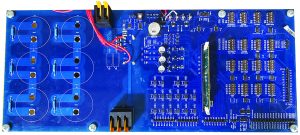IGBT Health Monitoring
MS student Michael Wu with advisor A. Banerjee
In locomotive applications, online monitoring of silicon component health in high-power inverters is crucial to preventing catastrophic failures during operation. Our proposed approach to online IGBT health monitoring involves creating a thermal model of the IGBT module that can estimate the silicon junction temperature. Accurately estimating the temperature swings inside the module will allow us to accumulate the total damage done to the IGBT, thus giving us the ability to estimate the health and remaining lifetime of the module.
The input into the thermal model is the total power loss inside the IGBT module. Lookup tables provided by the manufacturer give us the switching-loss values during turn-on and turn-off transients. These are too quick to be sampled and measured using online measurement circuitry. However, conduction loss in the IGBT and the freewheeling diode can be measured. The challenge in developing this circuitry is that it must have the ability to block high voltages (~3 kV) while measuring a comparatively small voltage (~3.5 V). Our work over the past year has revolved around developing and evaluating the performances of three different measurement topologies. The measurement circuits are tested at low power on a 3-phase inverter. Figure 1 shows the IGBT on-state measurement board and Figure 2 the IGBT driver board. This research is supported by CRRC Corp.

